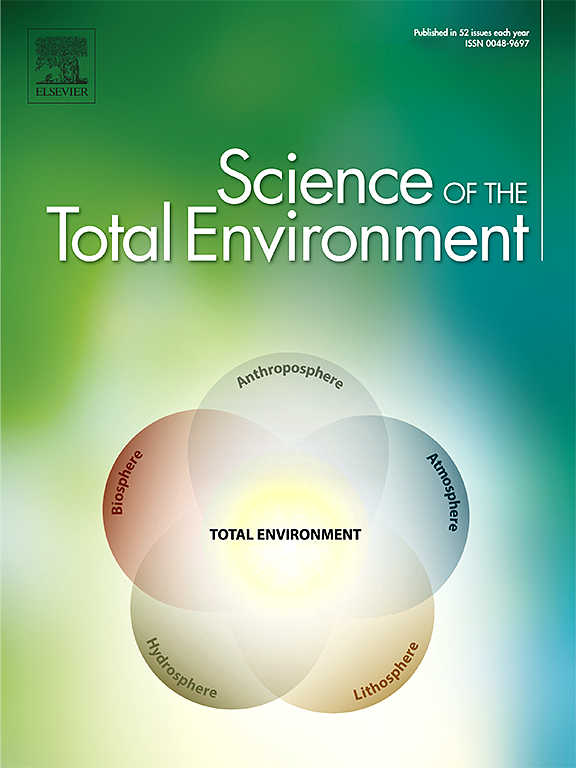Quantitative analysis of the polar cod (Boreogadus saida) hepatic proteome highlights interconnected responses in cellular adaptation and defence mechanisms after dietary benzo[a]pyrene exposure
IF 8.2
1区 环境科学与生态学
Q1 ENVIRONMENTAL SCIENCES
引用次数: 0
Abstract
Increased industrial offshore activities in northern waters raise the question of impact of polycyclic aromatic hydrocarbons (PAHs) on key Arctic marine species. One of these is the ecologically important polar cod (Boreogadus saida), which is the primary food source for Arctic marine mammals and seabirds. In the present work, we have conducted the first comprehensive proteomics study with this species by exploring the effects of dietary PAH exposure on the hepatic proteome, using benzo[a]pyrene (BaP) as a PAH model-compound. Functional annotation and pathway analyses of the proteins affected by BaP revealed a concerted cellular response for handling and adopting to its exposure, involving numerous interconnected signalling pathways and metabolic processes. In accordance with BaP being a strong aryl hydrocarbon receptor (Ahr) agonist, a prominent activation of the canonical Ahr signalling pathway was observed, including upregulation of Ahr target proteins like cytochrome P450 enzymes and microsomal glutathione transferase. Furthermore, cellular pathways for handling oxidative stress, protein misfolding and degradation, as well as endoplasmic reticulum stress and calcium homeostasis, were also activated by BaP, possibly as a result of the formation of harmful and redox reactive BaP metabolites via phase I metabolism. Activation of proteins that participate in the acute-phase response was also observed, suggesting prevalent tissue- and cellular damage that triggers the immune system and inflammatory responses. Our results at the protein level aligns well with previous analyses on the effects of BaP on the polar cod liver transcriptome and support that exposure to BaP and structural similar PAHs can cause adverse effects on polar cod physiology. Although more data is required for demonstrating how these molecular responses propagate to higher levels of biological organisation, increased knowledge about the initial cellular and molecular mechanisms that induce toxicity is a key-step towards a mechanistically informed impact assessment of PAH pollutants in the Arctic.

极地鳕鱼(Boreogadus saida)肝脏蛋白质组的定量分析强调了饮食中苯并[a]芘暴露后细胞适应和防御机制的相互关联反应。
北部海域海上工业活动的增加提出了多环芳烃(PAHs)对北极主要海洋物种影响的问题。其中之一是生态上重要的极地鳕鱼(Boreogadus saida),它是北极海洋哺乳动物和海鸟的主要食物来源。在目前的工作中,我们利用苯并[a]芘(BaP)作为多环芳烃模型化合物,通过探索饮食中多环芳烃暴露对肝脏蛋白质组的影响,对该物种进行了首次全面的蛋白质组学研究。受BaP影响的蛋白质的功能注释和途径分析揭示了处理和接受BaP暴露的协调细胞反应,涉及许多相互关联的信号通路和代谢过程。根据BaP是一种强芳基烃受体(Ahr)激动剂,观察到典型Ahr信号通路的显著激活,包括Ahr靶蛋白如细胞色素P450酶和微粒体谷胱甘肽转移酶的上调。此外,处理氧化应激、蛋白质错误折叠和降解以及内质网应激和钙稳态的细胞途径也被BaP激活,这可能是通过I期代谢形成有害和氧化还原反应性BaP代谢物的结果。参与急性期反应的蛋白质的激活也被观察到,这表明普遍的组织和细胞损伤触发了免疫系统和炎症反应。我们在蛋白质水平上的结果与之前关于BaP对极地鳕鱼肝脏转录组的影响的分析一致,并支持暴露于BaP和结构相似的多环芳烃会对极地鳕鱼生理产生不利影响。虽然需要更多的数据来证明这些分子反应如何传播到更高水平的生物组织,但增加对诱导毒性的初始细胞和分子机制的了解是对北极多环芳烃污染物的机械影响评估的关键一步。
本文章由计算机程序翻译,如有差异,请以英文原文为准。
求助全文
约1分钟内获得全文
求助全文
来源期刊

Science of the Total Environment
环境科学-环境科学
CiteScore
17.60
自引率
10.20%
发文量
8726
审稿时长
2.4 months
期刊介绍:
The Science of the Total Environment is an international journal dedicated to scientific research on the environment and its interaction with humanity. It covers a wide range of disciplines and seeks to publish innovative, hypothesis-driven, and impactful research that explores the entire environment, including the atmosphere, lithosphere, hydrosphere, biosphere, and anthroposphere.
The journal's updated Aims & Scope emphasizes the importance of interdisciplinary environmental research with broad impact. Priority is given to studies that advance fundamental understanding and explore the interconnectedness of multiple environmental spheres. Field studies are preferred, while laboratory experiments must demonstrate significant methodological advancements or mechanistic insights with direct relevance to the environment.
 求助内容:
求助内容: 应助结果提醒方式:
应助结果提醒方式:


